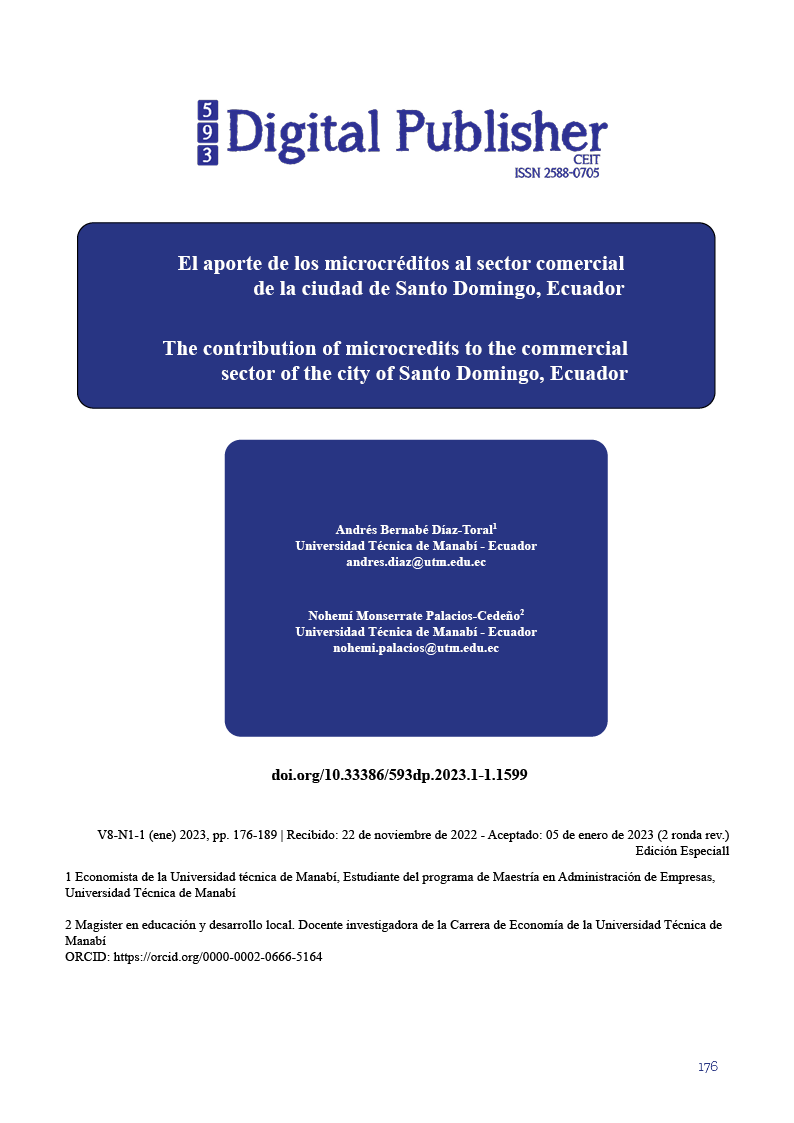The contribution of microcredits to the commercial sector of the city of Santo Domingo, Ecuador
Main Article Content
Abstract
Microcredits are not only an element to cover an emerging need for working capital, their importance has increased so much that they currently represent an important tool for the revitalization of the various commercial activities carried out by merchants and entrepreneurs from different social strata in urban, urban-marginal and rural sectors of different cities and cantons of Ecuadorian territory.
The research objective was focused on determining the contribution that microcredits make to the commercial sector of 3 de Julio Street in the city of Santo Domingo in Ecuador, through the application of a questionnaire to a non-probabilistic sample by convenience of 50 merchants of the sector, and consequently the use of the analysis method. The results revealed a higher percentage of women engaged in trade, with a primary education, whose age ranges between 51-60 years and a time of more than 21 years in the activity, predominantly clothing and footwear trade; who had a regular economic situation that changed to good when they used the microcredit in the business.
Most of the traders have obtained 1-3 microcredits of the extended accumulation type, with amounts greater than $10,000, granted by private banks with a frequency of application upon cancellation of the previous one. The benefits perceived include both for the business and the family, the increase in profits and improvement of the children's education; giving work to a family member, receiving larger amounts of credit; the microcredit is used for the purchase of merchandise.
Downloads
Article Details

This work is licensed under a Creative Commons Attribution-NonCommercial-ShareAlike 4.0 International License.
1. Derechos de autor
Las obras que se publican en 593 Digital Publisher CEIT están sujetas a los siguientes términos:
1.1. 593 Digital Publisher CEIT, conserva los derechos patrimoniales (copyright) de las obras publicadas, favorece y permite la reutilización de las mismas bajo la licencia Licencia Creative Commons 4.0 de Reconocimiento-NoComercial-CompartirIgual 4.0, por lo cual se pueden copiar, usar, difundir, transmitir y exponer públicamente, siempre que:
1.1.a. Se cite la autoría y fuente original de su publicación (revista, editorial, URL).
1.1.b. No se usen para fines comerciales u onerosos.
1.1.c. Se mencione la existencia y especificaciones de esta licencia de uso.
References
Álava, M., Rodríguez, S., & Marín, L. (2018). Microcréditos como fuente alternativa de financiamiento para las mipymes en ecuador. Conference Proceedings, 1(1), 547-557. http://invetigacion.utmachala.edu.ec/proceedings/index,php/utmach
Burgos, M., Guerrero, G., Mier, H., & Rodríguez, L. (2021). Características del microcrédito en la indsutria manufacturera de la ciudad de Pasto. Económicas CUC, 42(1), 54–77. https://doi.org/10.17981/econcuc.42.1.2021.Econ.4
Bustamante, K., & Cabrera, K. (2018). Microcrédito, microempresa y educación en Ecuador. Espacios, 38(53), 25-40. https://www.revistaespacios.com/a17v38n53/a17v38n53p25.pdf
Cárdenas, F., Ramos, C., Beltrán, Á., & Pazos, P. (2019). Sostenibilidad empresarial en relación a los objetivos de desarrollo sostenible en Ecuador. RECIAMUC, 3(1), 670-699. https://doi.org/10.26820/reciamuc/3.(1).enero.2019.670-699
Carvajal, A., & Espinoza, L. (2020). Microcréditos ecuatorianos: incentivo a la reducción de la pobreza y mejora del ingreso familiar. VÍNCULOS-ESPE, 5(3), 51-65. https://10.24133/vinculosespe.v5i3.1671
Casquete, N., Bautista, E., & Moreira, C. (2020). El desarrollo del microcrédito en la zona noroeste de Guayaquil, Ecuador. Publicando, 8(31), 107-116. https://doi.org/10.51528/rp.vol8.id2212
CEPAL. (2020). Los efectos del COVID-19 en el comercio internacional y la logística. Chile: CEPAL. https://www.cepal.org/es/publicaciones/45877-efectos-covid-19-comercio-internacional-la-logistica#:~:text=En%20esta%20coyuntura%2C%20en%20mayo,Jap%C3%B3n%20y%20la%20Uni%C3%B3n%20Europea.
Del Pozo, S. (2015). Los microcréditos como instrumento social. Madrid: Universidad Pontificia ICAI ICADE COMILLAS. https://repositorio.comillas.edu/rest/bitstreams/21264/retrieve
Escobar, M., & Hidalgo, M. (2020). Microcrédito: Alternativa de reactivación económica para comerciantes de Portoviejo, Manabí, Ecuador. Dominio de las ciencias, 6(2), 431-459. http://dx.doi.org/10.23857/dc.v6i2.1177
Gallardo, E. (2017). Metodología de la Investigación. Manual Autoformativo Interactivo, Primera edición. Perú: Universidad Continental. https://repositorio.continental.edu.pe/bitstream/20.500.12394/4278/1/DO_UC_EG_MAI_UC0584_2018.pdf
Garavito, D. (2016). Los microcréditos Evolución y situación actual del sistema de microfinanzas en Colombia. Univ. Estud. Bogotá (Colombia), 13(1), 49-72. https://repository.javeriana.edu.co/bitstream/handle/10554/44433/3.pdf?sequence=2&isAllowed=y
Inglada, M., Sastre, J., & De Miguel, M. (2015). Importancia de los microcréditos como instrumento de financiación en el desarrollo social. Revista Guillermo de Ockham, 13(2), 89-98. doi:https://doi.org/10.21500/22563202.2264
Jamaluddeen, D., & y Alam, S. (2022). THE IMPACT OF MICROFINANCE ON POVERTY REDUCTION THROUGH WOMEN’S EMPOWERMENT. Sachetas, 1(4), 21-31. Obtenido de https://sachetas.in/index.php/Sachetas/article/view/69/27
Lacalle, M. (2008). Microcréditos y pobreza. De un sueño al Nóbel de la Paz. Madrid: Turpial. https://dialnet.unirioja.es/servlet/libro?codigo=439093
Macías, T., González, S., Espinel, V., & Bravo, T. V. (2022). Rural beekeeping: Eco-friendly complement to traditional agriculture. International Journal of Mechanical Engineering, 7(2), 741-750. https://kalaharijournals.com/resources/FebV7_I2_83.pdf
Macías, T., Moreira, T., & Ormaza, M. (2020). Ingeniería industrial en los procesos de educación superior de la zona 4: Ecuador. International Journal of Advanced Science and Technology, 29(8), 5377-5388. http://sersc.org/journals/index.php/IJAST/article/view/32399
Macías, T., Pin, S., & Sancán, Z. (2021). Feasibility of the production of traditional palo bean coffee: an ancestral vision in barranco colorado. International Journal of perspectives economics, 15(1), 49-61. http://ijeponline.org/index.php/journal/article/view/9
Maldonado, M., & Armijos, L. (2017). Los microcréditos y su incidencia en el crecimiento económico de las MIPYMES. Sur Academi, 7(1), 19-24. https://revistas.unl.edu.ec/index.php/suracademia/article/view/475
Mesache, G. (2021). Los microcréditos y el sector agrícola del Ecuador, período 2005-2020. Riobamba: Universidad Nacional del Chimborazo. http://dspace.unach.edu.ec/bitstream/51000/8532/1/Mesache%20Alulema%20G.%20%282021%29%20Los%20microcr%C3%A9ditos%20y%20el%20sector%20agr%C3%ADcola%20del%20Ecuador%2C%20periodo%202005%20%E2%80%93%202020%20%28Tesis%20de%20Grado%29.pdf
Montalvo, R., Vásquez, J., & Amézquita, J. (2018). Desigualdad, microcréditos y desarrollo sostenible: un estudio en la Zona Metropolitana de Guadalajara. Ciencia Ergo Sum, 25(1), 21-33. https://doi.org/10.30878/ces.v25n1a2
Munish, K. (2016). Impact of Microcredit on Women Empowerment in India: An Empirical Study of Punjab State. Proceedings of the World Congress on Engineering 2016, Vol. II. London, UK: Organización de las Naciones Unidas. http://www.un.org/es/millenniumgoals/
Ñauñay, A. (2019). Los microcréditos de la agencia matriz de la cooperativa de ahorro y crédito Riobamaba Ltda. y su aporte en el emprendimiento de la ciudad de Riobamba. Riobamba: Universidad Nacional del Chimborazo. httpdspace.unach.edu.ecbitstream5100061981Los%20Microcr%C3%A9ditos%20de%20la%20agencia%20matriz%20de%20la%20Cooperativa%20de%20Ahorro%20y%20Cr%C3%A
Orozco, M. (14 de octubre de 2015). 10 nuevos tipos de crédito están en vigencia en Ecuador. El comercio, pág. 4. Obtenido de https://www.elcomercio.com/actualidad/nuevos-tipos-credito-vigentes-ecuador.html
Pacheco, G., Gernández, L., Medina, R., Montoya, L., & Borrero, T. (2016). de la administración de la microempresa en Barranquilla, Colombia. Revista Espacios, 37(9), 7-17. https://www.revistaespacios.com/a16v37n09/16370907.html
Paillacho, L., Pérez, J., & Pérez, A. (2020). Los microcréditos y el empoderamiento de grupos vulnerables. Un caso de estudio de jóvenes en Mbuji Mayi (Congo). Espacios, 41(7), 14-23. https://www.revistaespacios.com/a20v41n07/20410714.html
Palma, G., Erazo, C., & Sánchez, S. (2020). Factores externos imersos en el desarrollo finaciero de los comerciantes de Portoviejo Ecuador. Revista ECA Sinergia, 11(1), 19-26. https://revistas.utm.edu.ec/index.php/ECASinergia/article/view/1564/2386
Ricardo, D., Arango, L., & Taboada, R. (2020). Microcrédito y pobreza: su relación con el desarrollo endógeno local. Económicas CUC, 41(2), 237-252. https://doi.org/10.17981/econcuc.41.2.2020.Econ.5
Saltos, I. (2017). Los microcréditos y su incidencia en el endeudamiento del sector del comercio de Guayaquil. Guayaquil: Universidad Espíritu Santo. http://repositorio.uees.edu.ec/bitstream/123456789/1965/1/Los%20Microcre%CC%81ditos.pdf
Stephens, L., & Spiegel, M. (2009). Estadística, 4ta edicion. México: McGraw-Hill. https://www.academia.edu/44609733/Estad%C3%ADstica_Serie_Schaum_4ta_edici%C3%B3n_Murray_R_Spiegel_pdf_1_
Sultana, H., Jamal, M., & Najaf, D. (2017). Impact of Microfinance on Women Empowerment Through Poverty Alleviation: An Assessment of Socioeconomic Conditions in Chennai City of Tamil Nadu. Asian Journal For Poverty Studies, 3(2), 175 – 183. https://ejournal.unib.ac.id/index.php/ajps/article/view/2785
Vela, J., & Santillán, A. (10 de enero de 2022). asobanca.org. Obtenido de El microcrédito. el impulso para la reactivación económica: https://asobanca.org.ec/analisis-economico/el-microcredito-el-impulso-para-la-reactivacion-economica/
Weber, O., & Ahmad, A. (2015). Empowerment through Microfinance: The Relation between loan Cycle and level of Empowerment. World Development, 62(1), 75-87. https://doi.org/10.1016/j.worlddev.2014.05.012



